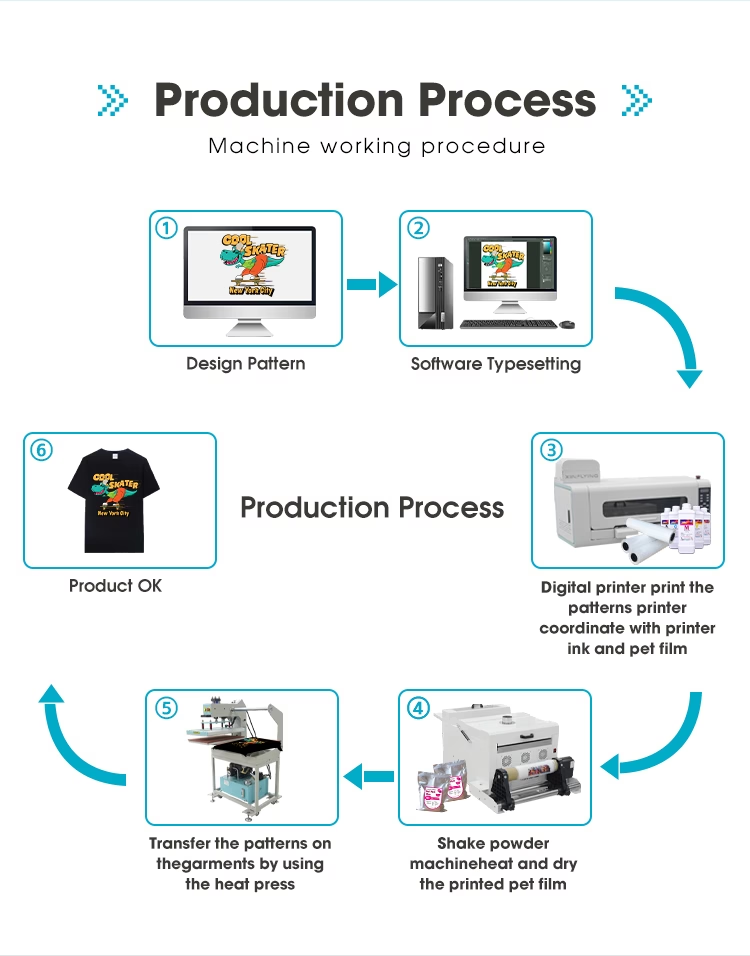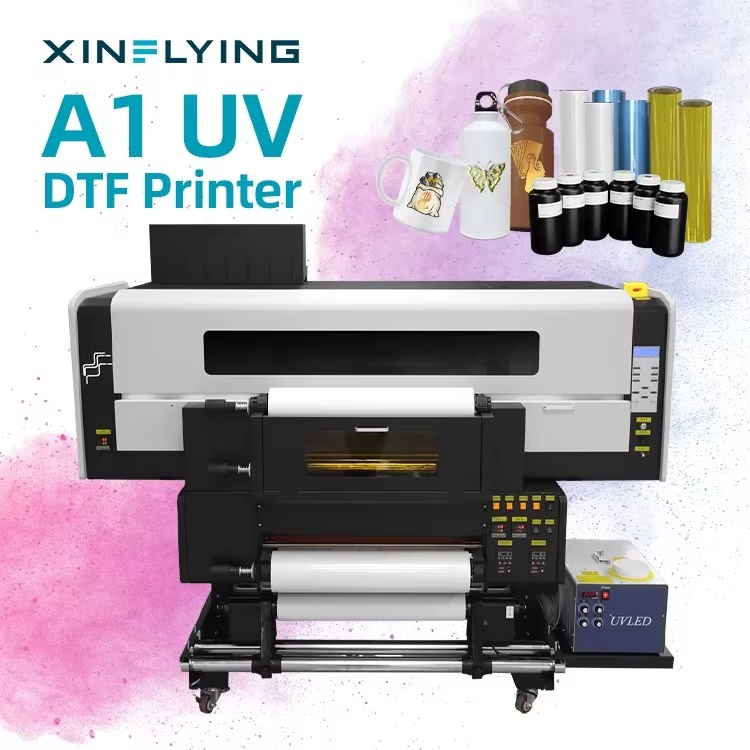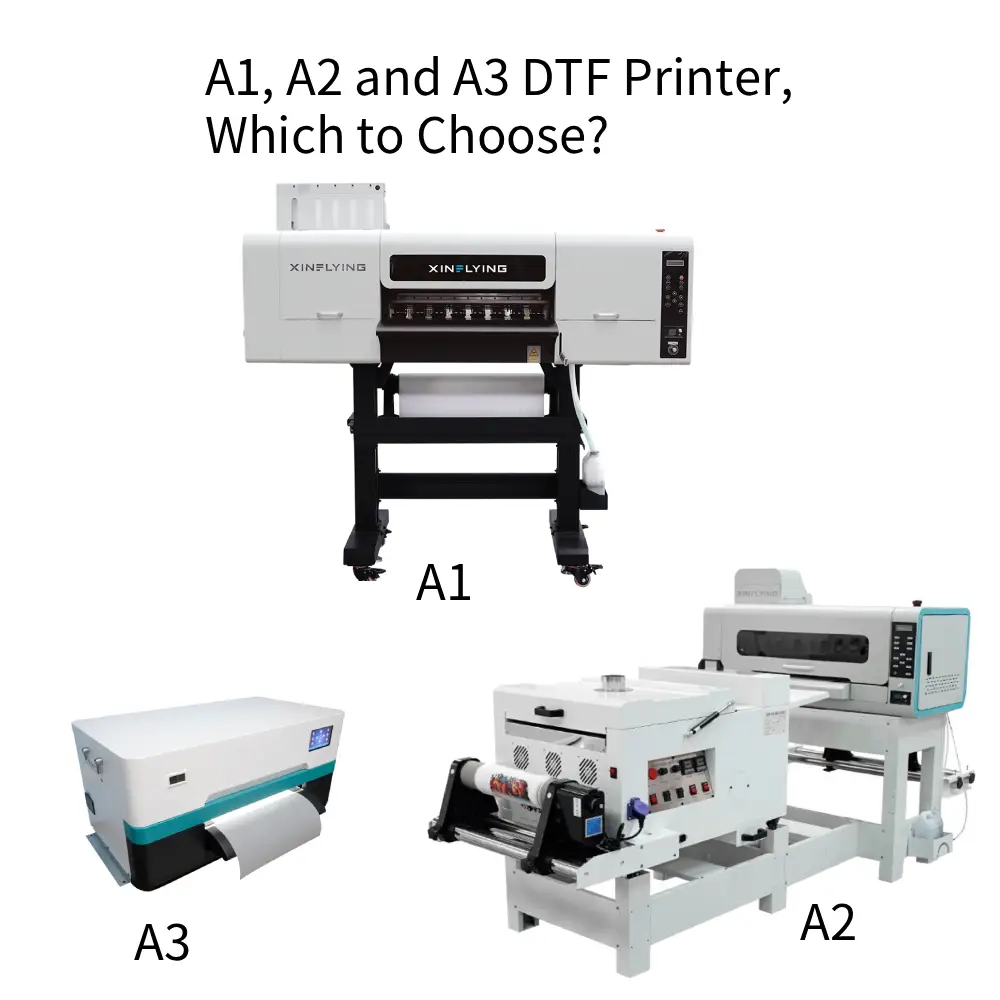उच्च गुणवत्ता वाले DTF प्रिंटों को प्राप्त करने के लिए कई कारकों पर ध्यान देने की आवश्यकता है, मुद्रण उपकरण और सामग्री से लेकर पर्यावरणीय परिस्थितियों तक. नीचे, हम आपके डीटीएफ प्रिंटिंग परिणामों को प्रभावित करने वाले प्रमुख पहलुओं और उन्हें अनुकूलित करने के तरीके के बारे में बता रहे हैं.
1. प्रिंटर प्रदर्शन
• प्रिंटहेड गुणवत्ता
प्रिंटहेड आपके प्रिंट की सटीकता और रिज़ॉल्यूशन निर्धारित करता है. छोटी बूंदों के आकार वाले उच्च गुणवत्ता वाले प्रिंटहेड अधिक तेज उत्पादन करते हैं, अधिक विस्तृत चित्र. उदाहरण के लिए, Epson प्रिंटहेड स्याही की बूंदों को छोटी मात्रा में वितरित कर सकते हैं 1.5 पिकोलिटर, बारीक विवरण और चिकने रंग ग्रेडिएंट सुनिश्चित करना.
• मुद्रण संकल्प
डीपीआई में मापा गया (प्रति इंच बिंदू), उच्च रिज़ॉल्यूशन अधिक विस्तृत और जीवंत प्रिंट प्रदान करता है. प्रवेश स्तर के डीटीएफ प्रिंटर आमतौर पर समर्थन करते हैं 720 डीपीआई, जबकि उन्नत मॉडल तक हासिल कर सकते हैं 2880 डीपीआई या उच्चतर.
• रंग प्रबंधन प्रणाली
एक उन्नत रंग प्रबंधन प्रणाली सटीक और सुसंगत रंग प्रजनन सुनिश्चित करती है. हाई-एंड प्रिंटर अक्सर कस्टम ICC प्रोफ़ाइल की अनुमति देते हैं, विशिष्ट अनुप्रयोगों के लिए सटीक रंग समायोजन सक्षम करना.
2. उपभोग्य
• स्याही की गुणवत्ता
जीवंतता के लिए उच्च गुणवत्ता वाली डीटीएफ स्याही का उपयोग करना महत्वपूर्ण है, टिकाऊ प्रिंट. प्रीमियम स्याही बेहतर रंग संतृप्ति प्रदान करती है, स्थिरता, और क्लॉगिंग के जोखिम को कम करते हुए धोने के प्रतिरोध को कम करता है. विश्वसनीय ब्रांडों से जुड़े रहें और रासायनिक प्रतिक्रियाओं को रोकने के लिए विभिन्न निर्माताओं की स्याही मिलाने से बचें.
• फिल्म की गुणवत्ता स्थानांतरित करें
स्थानांतरण फिल्म अंतिम आउटपुट में महत्वपूर्ण भूमिका निभाती है. एक चिकना, उच्च गुणवत्ता वाली फिल्म स्याही का समान वितरण और दोषरहित स्थानांतरण सुनिश्चित करती है. घटिया फ़िल्में लगाने के बाद धुंधली छवियाँ या छिलने का कारण बन सकती हैं.
• चिपकने वाला पाउडर
डीटीएफ प्रिंटिंग में उपयोग किया जाने वाला चिपकने वाला पाउडर प्रिंट की स्पष्टता और स्थायित्व को प्रभावित करता है. महीन पाउडर चुनें, समान आसंजन सुनिश्चित करने के लिए समान कण. खराब गुणवत्ता वाले पाउडर के परिणामस्वरूप असमान प्रिंट हो सकते हैं या स्थायित्व कम हो सकता है.
1. प्रिंटर सेटिंग्स
• रिज़ॉल्यूशन सेटिंग्स
डिज़ाइन की जटिलता के आधार पर रिज़ॉल्यूशन को समायोजित करें. विस्तृत विवरण के लिए उच्च रिज़ॉल्यूशन का उपयोग करें, समय और स्याही बचाने के लिए सरल डिज़ाइन के लिए जटिल ग्राफिक्स और कम रिज़ॉल्यूशन.
• रंग मोड
अपने प्रिंट कार्य के लिए सही रंग मोड चुनें. सीएमवाईके अधिकांश डिज़ाइनों के लिए आदर्श है, जबकि RGB ब्राइटनेस को बढ़ा सकता है, ज्वलंत रंग. उपयुक्त मोड का चयन इष्टतम रंग आउटपुट सुनिश्चित करता है.
• मुद्रण गति
मुद्रण गति गुणवत्ता को प्रभावित कर सकती है. तेज़ मुद्रण से स्याही का अनुप्रयोग असमान हो सकता है या विवरण कम हो सकता है, इसलिए अपनी आवश्यकताओं के अनुसार गति और गुणवत्ता को संतुलित करें.
1. सब्सट्रेट विशेषताएँ
• सतह की चिकनाई
एक चिकनी मुद्रण सतह स्याही के समान अनुप्रयोग को सुनिश्चित करती है. अनियमित सतहें असंगत प्रिंट या धुंधले विवरण का कारण बन सकती हैं. मुद्रण से पहले हमेशा सब्सट्रेट की स्थिति सत्यापित करें.
• स्याही अवशोषण
अच्छे स्याही अवशोषण वाले सब्सट्रेट जीवंत उत्पादन करते हैं, लंबे समय तक चलने वाले प्रिंट. खराब अवशोषक सामग्री स्याही जमाव का कारण बन सकती है, धुंधला होना, या लुप्त होती जा रही है. उत्पादन से पहले सब्सट्रेट अनुकूलता का परीक्षण करें.
• पूर्व उपचार
कुछ सामग्रियों को पूर्व-उपचार की आवश्यकता होती है, जैसे सफाई या कोटिंग, आसंजन और मुद्रण गुणवत्ता में सुधार करने के लिए. उदाहरण के लिए, यह सुनिश्चित करने के लिए कि स्याही सही ढंग से चिपकी हुई है, चमड़े की सतहों को अक्सर प्राइमर की आवश्यकता होती है.
1. वातावरणीय कारक
• तापमान
इष्टतम स्याही प्रवाह और सुखाने की गति के लिए ऑपरेटिंग तापमान 18°C-25°C बनाए रखें. अत्यधिक तापमान स्याही के प्रदर्शन और प्रिंट गुणवत्ता को प्रभावित कर सकता है.
• नमी
बीच में नमी का स्तर बनाए रखें 40%-60%. उच्च आर्द्रता स्याही के सूखने को धीमा कर सकती है, दाग पैदा करना, जबकि कम आर्द्रता के कारण प्रिंटहेड में स्याही सूख सकती है, रुकावट पैदा कर रहा है.
• वेंटिलेशन
एक अच्छी तरह हवादार कार्यस्थल स्याही को समान रूप से सूखने में मदद करता है और धुएं के निर्माण को कम करता है. खराब वेंटिलेशन से ऑपरेटरों के लिए असंगत सुखाने और संभावित स्वास्थ्य जोखिम हो सकते हैं.
चाबी छीनना
उत्कृष्ट डीटीएफ मुद्रण परिणाम प्राप्त करने के लिए:
1. उच्च गुणवत्ता वाले प्रिंटर और संगत उपभोग्य सामग्रियों में निवेश करें.
2. अपने उपकरणों का नियमित रखरखाव करें, विशेषकर प्रिंटहेड.
3. प्रत्येक प्रोजेक्ट के लिए प्रिंटर सेटिंग्स अनुकूलित करें.
4. संगत का प्रयोग करें, अच्छी तरह से तैयार सब्सट्रेट.
5. अपने कार्यस्थल के तापमान को नियंत्रित करें, नमी, और वेंटिलेशन.
इन कारकों पर बारीकी से ध्यान देकर, आप जीवंत उत्पादन कर सकते हैं, टिकाऊ, और हर बार पेशेवर-गुणवत्ता वाला DTF प्रिंट होता है.







